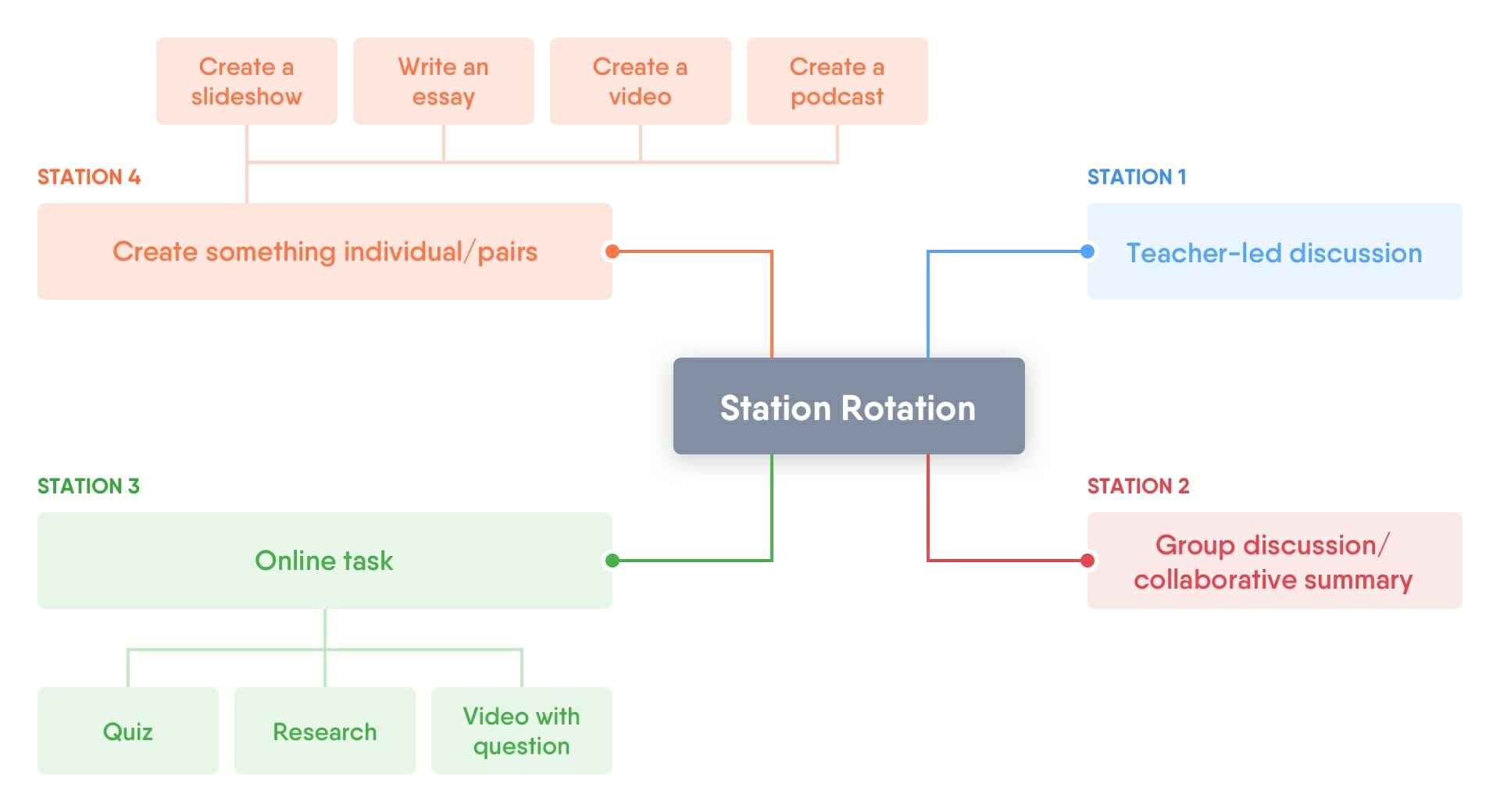Rotate your classroom with Station Rotation Model
Imagine a classroom where the students can spend their class time passing an engaging online course, collaborating on creative projects with their peers, and getting on-time support from a teacher. No rows of desks lined up facing a wall, no boring instruction. Seems unbelievable? Blended learning and virtual station rotation model lessons make it possible!

Station Rotation model definition
One of the most popular blended learning models is the Station Rotation model. It transfers a traditional theory-based classroom into a virtually enriched, hands-on workshop. Unlike other blended learning models, the Station Rotation model takes place within the physical classroom or training room.
During the classroom, students rotate on a fixed schedule among various modalities, which usually include 3 learning stations: 1) online learning; 2) face-to-face instruction; 3) group projects. For example, a learner may complete an assignment online, then participate in a group activity, and, finally, engage in teacher-led instruction. Students tend to be grouped by learning styles, skills, or needs.
The Station Rotation model is most traditionally utilized in schools, however, it can be effective within an organization too.
Before diving into the Station Rotation model, discover what blended learning means first.
Benefits of the Station Rotation model
Here are the benefits of the station rotation model:
- Personalized learning experiences.
By working in small groups at a station, the teacher or trainer is able to pay closer attention to and support individual learners. It enables the trainer to create dynamic lesson plans that better address individuals’ or groups’ specific learning needs. By incorporating a 1-to-1 station, the learner can also benefit from direct, personal instruction from the trainer. - Variety in learning methods improves knowledge retention.
By rotating through varied learning stations, learners benefit from repetition and increased engagement with the subject matter – helping them beat the forgetting curve. - Collaborative learning improves learning.
A lot of research has shown that group work, collaborative learning, and a collective thinking approach ultimately lead to deeper learning.
Limitations of the Station Rotation model
It’s also worth considering the challenges of the station rotation model:
- Lacks the agency of other blended learning models.
One of the drawbacks of the station rotation model is that learners are moved through the stations after a fixed time; for some this time may not be enough for them to grasp the learning at their own pace. Other blended models, such as the flipped classroom, enable students to learn at their own pace, in their own time, outside of the classroom. - Requires investment in e-learning technology.
One of the stations in this Rotation model is online learning. This requires an initial investment from the organization or school — both in devices and e-learning programs or tools. However, the benefits of incorporating e-learning into this model and organizing station rotation lessons can far outweigh the initial outlay. - The Station Rotation model doesn’t work for all subjects.
Some practitioners have found this model doesn’t work well in situations where learners must progress on a specific topic week by week – such as mathematics.
Implementing a Station Rotation Model
A Station Rotation classroom can’t be implemented on a whim. It’s a model you need to spend time planning, but once you do it’s simple to implement. Mindmaps are a good way of visualizing each station and the activities at each station. Here’s an example:

Remember to also think about how you will also provide instructions for each station and how long each station should take.
Limit your groups to no larger than 10 learners, but consider if you want to group them by skills, learning styles, or mixed abilities.
You should also consider the physical elements of the Rotation model – how will learners move between each station. Will they physically move, or is a new station a new set of instructions at the same location?
The role of e-learning in the Station Rotation model
The most difficult part while integrating a blended learning Station Rotation model is to create an interactive, well-designed, and didactically sound online course. However, with the help of user-friendly, low-cost, cloud-based authoring tools like Easygenerator, creating the e-learning station of your Rotation model needn’t be difficult, time-consuming, or expensive.
Using a cloud-based system enables you to also take advantage of learners’ own devices – all they need is an internet connection to access the online learning station – thus removing any device or access costs.
The e-learning station can be utilized in a number of ways. For example:
- Quizzes to assess their knowledge
- Research tasks
- Interactive activities and scenarios
- Reading and digesting learning content
There is a multitude of benefits to incorporating an e-learning station into your classroom. Chiefly, e-learning is more engaging. It’s interactive and fun and allows your students or employees to learn while doing it. It also makes tracking your learnes’ performance incredibly easy, as well as provides valuable data on how they’ve interacted with the learning content. And of course, as Millenials become a dominant sector of your workforce, these digital methods will be more natural and comfortable for your learners.
Free 14-day free trial with Easygenerator
Easygenerator is the perfect partner for creating your e-learning station in your Rotation model. As a cloud-based e-learning authoring tool with a zero learning curve, it enables you to easily create, update, share and track your online learning. Give it a try with a no-obligation 14-day trial.
 14 day trial with access to all features. Start with variety of course templates.
14 day trial with access to all features. Start with variety of course templates. Get unlimited design inspirations. Level up your courses.
Get unlimited design inspirations. Level up your courses. Upload your PowerPoint presentations. Get instant courses created.
Upload your PowerPoint presentations. Get instant courses created.


























